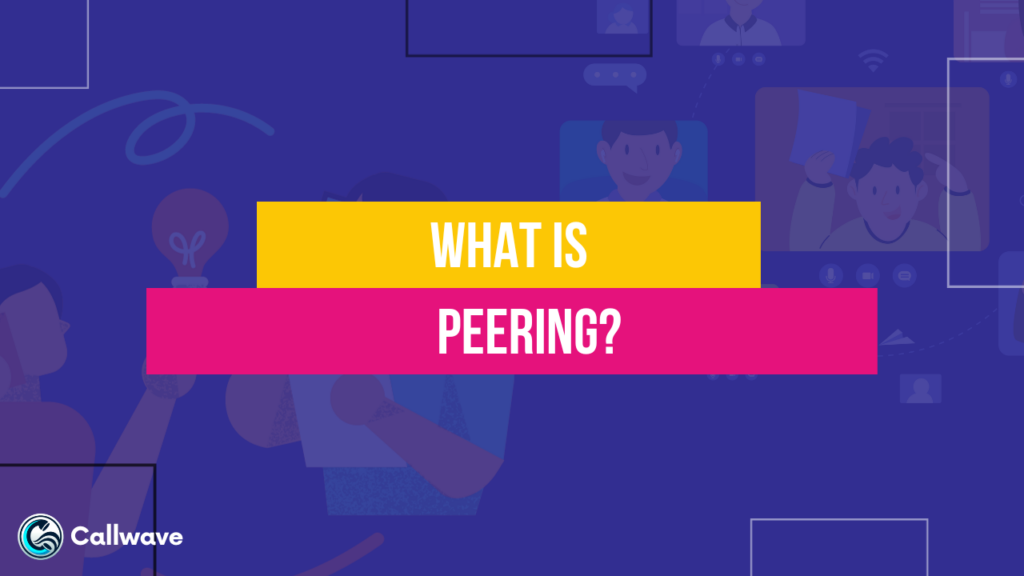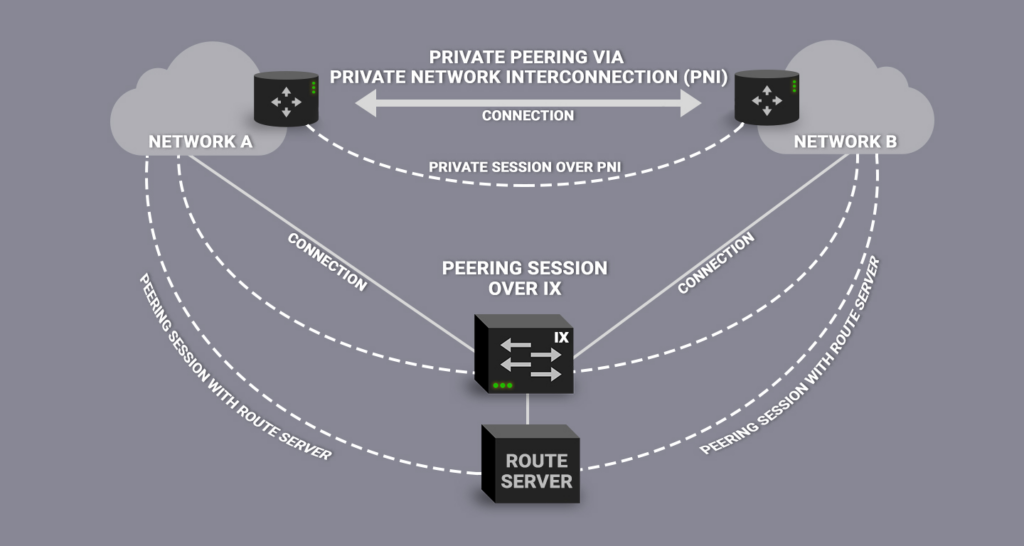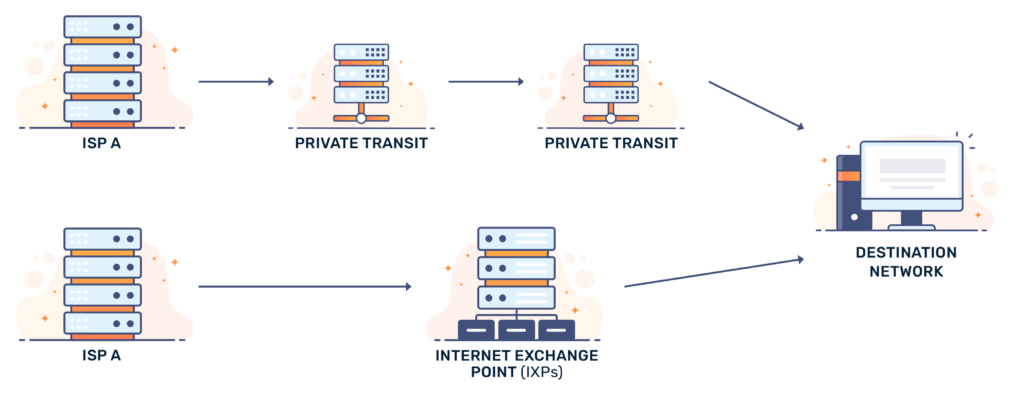Peering is a relationship between Internet service providers (ISPs) or other large networks whereby they directly interconnect for the exchange of traffic.
Rather than paying a third party to carry traffic across the internet, peers agree to exchange traffic between their users freely, and for mutual benefit.
Peers must meet certain qualifications like size and network capability to establish a peering relationship.
The connections established between peers are known as peering points or peering exchanges. These peering points allow for the direct exchange of customer traffic between two networks.
To peer with one another, networks must meet certain criteria. Generally, a network needs to have a nationally significant presence, provide value to its peer, and carry traffic volumes necessary to justify direct interconnection.
Peers are often large ISPs, content delivery networks, cloud providers, and other sizable networks. The mutually beneficial flow of traffic between peers provides an incentive to participate in peering.

How Does Peering Work?
When two networks peer, they establish a direct physical interconnection to exchange traffic. This is often facilitated through an Internet exchange point (IXP).
IXPs provide a facility where multiple networks can collaborate equipment and connect directly. The connections at the IXP allow the peered networks to bypass third-party transit providers to exchange traffic between their users.
Peers use the Border Gateway Protocol (BGP) to exchange routing information and inform each other of the routes reachable through their networks.
Based on BGP data, the peers will shift traffic flows to use available direct peering links rather than routing through a transit provider.
The peering relationship allows the direct exchange of traffic that is destined for the users of a peered network. If traffic cannot be exchanged over peering, then connections to transit providers are used.
Settlement-free peering relies on a roughly equal exchange of traffic between peers. If the traffic exchange becomes significantly imbalanced, paid peering or transit agreements are established.

Types of Peering
There are a few different types of peering relationships that networks may establish:
- Private peering – Direct interconnection between two networks in a private location. This allows peers to manage their infrastructure and terms of the relationship through privately owned circuits.
- Public peering – Peering at a public Internet exchange point (IXP). IXPs allow multiple networks to interconnect in a colocation facility and peer with each other.
- Paid peering – Peering where one network pays the other based on directional traffic flow. Used when traffic volumes are highly imbalanced between peers.
- Settlement-free peering – Voluntary peering between two networks to exchange traffic on a zero-cost basis. A most common type of peering between large networks.
Benefits of Peering
Several benefits peering provides:
- Cost savings – By peering, networks exchange traffic between their users directly rather than purchasing transit or paying for traffic exchange. This reduces costs substantially.
- Improved performance – Direct connections between peers allow for fewer hops, lower latency, and better throughput for traffic exchange between users on peered networks.
- Redundancy – Peering gives networks alternative paths for reaching destinations if connectivity failures occur. Having redundant peering links improves reliability.
- Traffic localization – Peering localizes traffic exchange by allowing direct interconnects between networks. Localized traffic stays within a region rather than unnecessarily traversing long distances.
- Innovation incentives – Settlement-free peering encourages networks to innovate and provide better connectivity to their customers, as they don’t have to pay third parties for traffic exchange.

Challenges with Peering
Some challenges can arise with peering relationships:
- Traffic imbalances – If one peer sends significantly more traffic than it receives, the other peer may move to a paid peering or transit model. This requires monitoring traffic levels.
- Competition among peers – Peers may compete for the same customers in some cases. There needs to be sufficient mutual benefit to overcome business competition.
- Configuration complexity – Setting up direct peering connections requires configuring routing policies and filters between peers. This can become complex as the number of peers grows.
- Lack of SLA guarantees – Peers often do not provide guaranteed service levels, since there are no payments involved. This requires careful monitoring of peering performance.
- Troubleshooting issues – Determining the source of problems with interconnections or traffic exchange can be difficult with peering. Cooperation between peer engineering teams is crucial.
Peering Locations and Exchanges
Peering allows direct interconnection between networks in different locations worldwide:
- Public exchanges – Carrier-neutral IXPs like DE-CIX, LINX, and AMS-IX allow multiple networks to interconnect in metros globally.
- Private exchanges – Colocation facilities provide private interconnect options for networks, like Equinix Cloud Exchange.
- Direct peering – When there is sufficient traffic, networks will establish direct private peering, like between content networks and ISPs.
- Regional exchanges – To enable localized traffic exchange, regional IXPs are located across different geographies. In the US, exchanges like Any2, WXP, and SIX allow interconnection between networks.
Major global cities with significant peering interconnections include London, New York, San Francisco, Los Angeles, Frankfurt, Amsterdam, and Hong Kong.
But Internet exchange points exist in many metro areas to enable localized peering.

Peering Disputes
There is sometimes conflict between large networks over peering terms and conditions. Here are a few examples of peering disputes:
- Netflix vs ISPs (2014) – Netflix wanted free peering with last-mile ISPs like Comcast and Verizon to deliver video traffic. ISPs wanted payments for carrying large Netflix traffic volumes.
- Cogent vs Telia (2016) – Cogent and Telia ended a settlement-free peering arrangement after a traffic imbalance emerged. This caused congestion between the network users.
- Google vs AT&T (2013) – Google’s YouTube video traffic through peering connections to AT&T started experiencing degradation. After a public dispute, the issue was resolved.
- Microsoft vs Sony (2014) – Sony’s PlayStation network requested free peering with Microsoft’s Xbox ecosystem. Microsoft stated Sony did not meet its peering criteria.
- L3 vs Cogent (2005) – Cogent stopped paying L3 for peering after traffic volumes became more balanced. L3 departed Cogent, resulting in massive slowdowns.
Peering disputes often arise around traffic imbalances and uncompensated transit. However large networks depend on peering and have incentives to resolve conflicts.

Frequently Asked Questions (FAQ)
Ques 1. What is a peering fabric?
Ans. A peering fabric refers to the dense web of interconnections established through peering agreements between many different networks.
The global peering fabric allows connectivity between thousands of individual networks that collectively make up the Internet.
Ques 2. Can small networks peer?
Ans. Generally, no. Due to traffic volume requirements, small networks don’t usually qualify to set up direct peering.
Instead, they will purchase transit from a larger network to access the rest of the Internet. However, some options like open peering allow smaller networks to interconnect at IXPs.
Ques 3. What is the difference between peering and transit?
Ans. Peering is the voluntary, settlement-free exchange of traffic between two networks.
Transit is a commercial arrangement where one network pays another to provide access to the global Internet routing table. Peering partners are often also transit customers and providers.
Ques 4. How are peering disputes resolved?
Ans. Peering disputes tend to be resolved through private negotiations once dependence starts to significantly affect end users.
Public pressure on large carriers, involvement by regulators, migrating traffic to other networks, and threatening litigation can all force the resolution of peering conflicts.
Ques 5. Why are Internet exchange points important for peering?
Ans. IXPs provide crucial meeting points for networks to interconnect and peer physically. They reduce costs and maximize peering opportunities through colocation facilities.
IXPs boost local and regional traffic exchange. Major IXPs also serve as peering hubs for global Internet traffic exchange.






